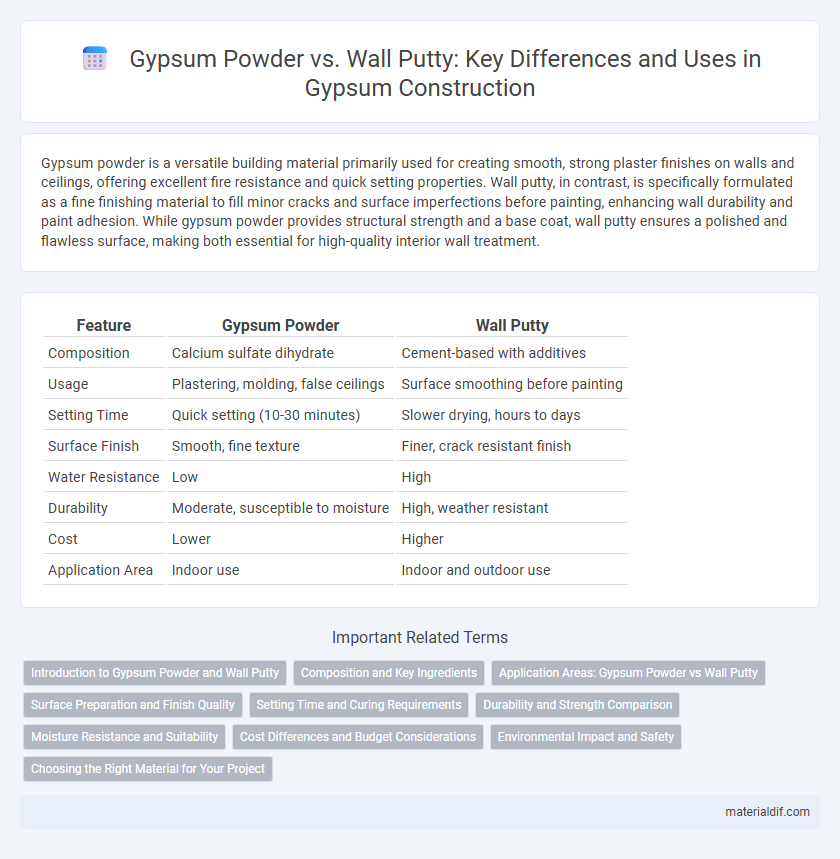Gypsum powder is a versatile building material primarily used for creating smooth, strong plaster finishes on walls and ceilings, offering excellent fire resistance and quick setting properties. Wall putty, in contrast, is specifically formulated as a fine finishing material to fill minor cracks and surface imperfections before painting, enhancing wall durability and paint adhesion. While gypsum powder provides structural strength and a base coat, wall putty ensures a polished and flawless surface, making both essential for high-quality interior wall treatment.
Table of Comparison
| Feature | Gypsum Powder | Wall Putty |
|---|---|---|
| Composition | Calcium sulfate dihydrate | Cement-based with additives |
| Usage | Plastering, molding, false ceilings | Surface smoothing before painting |
| Setting Time | Quick setting (10-30 minutes) | Slower drying, hours to days |
| Surface Finish | Smooth, fine texture | Finer, crack resistant finish |
| Water Resistance | Low | High |
| Durability | Moderate, susceptible to moisture | High, weather resistant |
| Cost | Lower | Higher |
| Application Area | Indoor use | Indoor and outdoor use |
Introduction to Gypsum Powder and Wall Putty
Gypsum powder is a fine white powder made by grinding synthetic or natural gypsum, primarily used in construction for plastering and as a key ingredient in drywall boards. Wall putty is a white cement-based coating material applied on interior walls to fill cracks, smooth surfaces, and provide an ideal base for painting. While gypsum powder offers quick-setting and smooth finishing properties, wall putty enhances surface durability and wall aesthetics by preventing paint peeling and providing resistance against moisture.
Composition and Key Ingredients
Gypsum powder primarily consists of calcium sulfate dihydrate obtained by heating natural gypsum rock, making it highly effective for plastering and molding due to its rapid setting properties. Wall putty, however, is formulated with white cement, fine kaolin clay, and additives that enhance adhesion, smoothness, and water resistance for wall finishing. The distinct compositions dictate gypsum powder's strength in structural applications, whereas wall putty excels in providing a smooth, durable surface for painting.
Application Areas: Gypsum Powder vs Wall Putty
Gypsum powder is widely used in interior wall plastering, ceiling decoration, and creating intricate moldings due to its quick setting and smooth finish properties. Wall putty is primarily applied as a protective coating on walls and ceilings to fill minor cracks and create a smooth, ready-to-paint surface, enhancing durability and water resistance. The choice between gypsum powder and wall putty depends on the surface condition and desired finish quality in construction and renovation projects.
Surface Preparation and Finish Quality
Gypsum powder offers excellent surface preparation by ensuring smoothness and quick setting, making it ideal for leveling walls before painting. Wall putty, however, excels in filling minor cracks and imperfections, creating a durable, water-resistant finish that enhances paint adhesion. Combining gypsum powder for base smoothing and wall putty for final touch-ups results in superior finish quality with long-lasting aesthetics.
Setting Time and Curing Requirements
Gypsum powder typically sets within 20 to 30 minutes, requiring minimal curing time and allowing for faster project completion. Wall putty, however, demands a longer curing period of 7 to 14 days to achieve optimal hardness and adhesion. The quicker setting time of gypsum powder makes it ideal for rapid repairs, while wall putty provides a durable and smooth finish after thorough curing.
Durability and Strength Comparison
Gypsum powder, composed primarily of calcium sulfate dihydrate, offers moderate strength and is prone to brittleness when used alone, while wall putty, formulated with fine fillers and binding agents, delivers enhanced durability and adhesion on wall surfaces. Wall putty provides a stronger, more resilient coating that resists cracking and moisture damage better than gypsum powder, making it ideal for finishing and protecting walls. The superior binding properties of wall putty contribute to a longer-lasting, smooth surface, unlike the relatively fragile and less cohesive gypsum powder.
Moisture Resistance and Suitability
Gypsum powder has limited moisture resistance, making it less suitable for areas exposed to high humidity or water contact, whereas wall putty offers enhanced moisture resistance, protecting walls from dampness and mold. Wall putty creates a smooth, durable surface ideal for exterior and interior walls prone to moisture, while gypsum powder is best used in dry indoor conditions for quick setting and smooth finishes. Choosing wall putty enhances the longevity and appearance of walls in humid environments, whereas gypsum powder prioritizes ease of application and finishing in moisture-free areas.
Cost Differences and Budget Considerations
Gypsum powder is generally more cost-effective than wall putty, making it a preferred choice for large-scale construction projects with tight budgets. Wall putty, while offering superior surface smoothness and durability, typically incurs higher expenses due to its refined composition and application process. Budget considerations must balance initial material costs against long-term benefits like finish quality and maintenance requirements when choosing between gypsum powder and wall putty.
Environmental Impact and Safety
Gypsum powder is made from natural mineral sources and is generally considered environmentally friendly due to its biodegradability and low VOC emissions, making it safer for indoor air quality compared to synthetic wall putty. Wall putty often contains chemicals and additives that can release volatile organic compounds (VOCs) during application and drying, posing potential health risks and environmental concerns. Proper disposal and use of gypsum powder reduce environmental impact, while wall putty requires careful handling and ventilation to ensure safety.
Choosing the Right Material for Your Project
Gypsum powder offers excellent smoothness and quick setting properties, making it ideal for interior wall plastering and ceilings, while wall putty provides superior surface finishing and crack resistance for painted walls. Selecting the right material depends on the project's requirements: gypsum powder suits structural finishing, and wall putty enhances the durability and aesthetic of the paint layer. Consider factors like surface preparation, environmental conditions, and desired finish quality to ensure optimal results with either gypsum powder or wall putty.
Gypsum Powder vs Wall Putty Infographic

 materialdif.com
materialdif.com